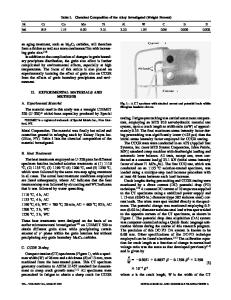Integranular Fracture: The Effect of Grain Boundary Orientation and Crack Growth Directions
- PDF / 928,566 Bytes
- 12 Pages / 420.48 x 639 pts Page_size
- 69 Downloads / 283 Views
granular fracture in such relatively simple systems and apply what is learned to intergranular fracture in materials of commercial and industrial interest. A symmetric tilt grain boundary separates two crystals that are oriented to be mirror images of one another. An example of how to construct a symmetric tilt grain boundary is shown in Fig. 1, where the { 1ll } family of slip planes is shown schematically in a face-centered cubic crystal. A bicrystal that contains a symmetric tilt grain boundary can be created by reflecting the crystal in Fig. 1 about its [ 110] - [114] plane. The mirror plane would become, in this case, a X9[ 110]/(221 ) symmetric tilt coincident site lattice grain boundary. The designation Z9 indicates that one out of every nine atomic positions in the two crystals coincide in space, the designation [ 1101 indicates the tilt axis of the symmetric tilt grain boundary, and the designation (221 ) indicates which atomic planes are joined at the grain boundary. When considering the fracture properties of this grain boundary, we will restrict the crack front to be nominally parallel to the [110] direction such that the crack propagates either in [114] or [114]. Frost, Ashby and Spaepen [2] tabulated the different types of coincident site lattice symmetric tilt grain boundaries that can be constructed in face-centered cubic crystals. MOTIVATION FOR INVESTIGATING SYMMETRIC TILT GRAIN BOUNDARIES There are many issues of intergranular fracture that can be addressed with symmetric tilt gramn boundaries. The first is that of the structural dependence of fracture. It is well established 219 Mat. Res. Soc. Symp. Proc. Vol. 586 © 2000 Materials Research Society
_00
[114]
Figure 1 Schematic of one-half of Y9[ 110]/(221) symmetric tilt bicrystal. The { 1111 family of slip planes in face-centered cubic crystal is indicated. that the behavior of a crack on the grain boundary of a symmetric tilt bicrystal depends not only on the crystallographic plane on which the crack resides, but also critically upon the crystallographic direction in which the crack propagates. Under identical loading conditions, a crack oriented in one crystallographic direction can propagate readily, while a crack oriented in the opposite direction propagates much less. For example, Wang and Anderson [3] have shown that the 19 [110]/(221 ) symmetric tilt coincident site lattice grain boundary of copper, for which the interface is weakened with Bi segregation, exhibits a directional dependence of fracture under a fatigue loading. Other researchers [4][5][6] have found similar behavior in a variety of material systems. Most of these authors attribute the directional dependence of fracture to differences in the ability or inability of dislocations to nucleate at crack tips; those crack tips which can nucleate dislocations are blunted, which presumably leads to a more ductile behavior. For example, Wang and Anderson [3] used an analytical approach formulated by Rice and Thomson [7] to calculate the relative propensities of the cracks in their
Data Loading...










